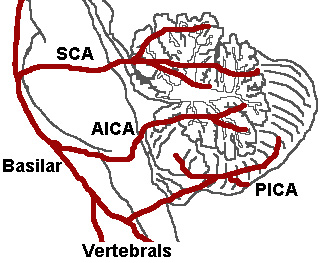Lateral medullary syndrome: Difference between revisions
Jump to navigation
Jump to search
No edit summary |
|||
| Line 16: | Line 16: | ||
{{CMG}} | {{CMG}} | ||
{{SK}} Wallenberg's syndrome; posterior inferior cerebellar artery syndrome | {{SK}} Wallenberg's syndrome; posterior inferior cerebellar artery syndrome (PICA) | ||
==Overview== | ==Overview== | ||
==Historical Perspective== | ==Historical Perspective== | ||
<br /> | |||
==Pathophysiology== | ==Pathophysiology== | ||
<br /> | |||
==Natural History, Complications and Prognosis== | ==Natural History, Complications and Prognosis== | ||
<br /> | |||
== Diagnosis == | == Diagnosis == | ||
===Symptoms=== | ===Symptoms=== | ||
Symptoms include | Symptoms include: | ||
*[[Ageusia]] or [[loss of taste]] on one side of the [[tongue]] | *[[Ageusia]] or [[loss of taste]] on one side of the [[tongue]] | ||
*[[Ataxia]] or [[incoordination]] | *[[Ataxia]] or [[incoordination]] | ||
| Line 42: | Line 41: | ||
*[[Facial pain]] | *[[Facial pain]] | ||
*[[Falling]] | *[[Falling]] | ||
*Palatal myoclonus | |||
*[[Hiccups]] | *[[Hiccups]] | ||
*[[Hoarseness]] | *[[Hoarseness]] | ||
| Line 49: | Line 49: | ||
*[[Nystagmus]] or [[rapid involuntary movements of the eyes]] | *[[Nystagmus]] or [[rapid involuntary movements of the eyes]] | ||
*[[Nausea and vomiting]] | *[[Nausea and vomiting]] | ||
*[[Vertigo_(medical)|Vertigo]] | *[[Vertigo_(medical)|Vertigo]] | ||
===Physical Examination=== | ===Physical Examination=== | ||
====Neurologic==== | ====Neurologic==== | ||
* | *Contralateral sensory deficits (pain and temperature sensation) affecting the trunk and extremities | ||
* | *Ipsilateral sensory deficits (pain and temperature sensation) affecting the face and cranial nerves | ||
**absence of pain on the ipsilateral side of the face, as well as an absent [[corneal reflex]] (Damage to the spinal [[trigeminal nucleus]]) | |||
*[[Ataxia]] | *[[Ataxia]] | ||
*[[Nystagmus]], | *[[Nystagmus]], | ||
*[[Horner's syndrome]] | *[[Horner's syndrome]] | ||
* | *Ipsilateral vocal fold paralysis | ||
*Palatal and pharyngeal paresis | |||
* | |||
===MRI=== | ===MRI=== | ||
[[Image:Wallenberganon_Image001.jpg|thumb|left|Clinical B1000 diffusion weighted MRI image showing an acute left sided dorsal lateral medullary infarct]] | [[Image:Wallenberganon_Image001.jpg|thumb|left|Clinical B1000 diffusion weighted MRI image showing an acute left sided dorsal lateral medullary infarct]] | ||
{{clr}} | {{clr}} | ||
===Localization of the Lesion=== | ===Localization of the Lesion=== | ||
| Line 83: | Line 96: | ||
==Treatment== | ==Treatment== | ||
<br /> | |||
==References== | ==References== | ||
<references/> | <references /> | ||
==External links== | ==External links== | ||
Revision as of 23:08, 25 July 2020
| Lateral medullary syndrome | |
 | |
|---|---|
| The three major arteries of the cerebellum: the SCA, AICA, and PICA. (Posterior inferior cerebellar artery is PICA.) | |
| ICD-10 | G46.3 |
| DiseasesDB | 10449 |
| MeSH | D014854 |
Editor-In-Chief: C. Michael Gibson, M.S., M.D. [1]
Synonyms and keywords: Wallenberg's syndrome; posterior inferior cerebellar artery syndrome (PICA)
Overview
Historical Perspective
Pathophysiology
Natural History, Complications and Prognosis
Diagnosis
Symptoms
Symptoms include:
- Ageusia or loss of taste on one side of the tongue
- Ataxia or incoordination
- Diplopia or double vision
- Dizziness
- Dysphagia or difficulties with swallowing
- Dysphonia or hoarseness
- Dysarthria or slurred speech
- Facial pain
- Falling
- Palatal myoclonus
- Hiccups
- Hoarseness
- Impaired gait
- Impaired coordination
- Hypesthesia or lack of pain and temperature sensation on only one side of the face
- Nystagmus or rapid involuntary movements of the eyes
- Nausea and vomiting
- Vertigo
Physical Examination
Neurologic
- Contralateral sensory deficits (pain and temperature sensation) affecting the trunk and extremities
- Ipsilateral sensory deficits (pain and temperature sensation) affecting the face and cranial nerves
- absence of pain on the ipsilateral side of the face, as well as an absent corneal reflex (Damage to the spinal trigeminal nucleus)
- Ataxia
- Nystagmus,
- Horner's syndrome
- Ipsilateral vocal fold paralysis
- Palatal and pharyngeal paresis
MRI

Localization of the Lesion
| Dysfunction | Effects |
| lateral spinothalamic tract | contralateral deficits in pain and temperature sensation from body |
| spinal trigeminal nucleus | ipsilateral loss of pain and temperature sensation from face |
| nucleus ambiguus (which affects vagus X and glossopharyngeal nerves IX) | dysphagia, hoarseness, diminished gag reflex |
| vestibular system | vertigo, diplopia, nystagmus, vomiting |
| descending sympathetic fibers | ipsilateral Horner's syndrome |
| central tegmental tract | palatal myoclonus |
Treatment
References
External links
Template:Diseases of the nervous system Template:Lesions of spinal cord and brainstem